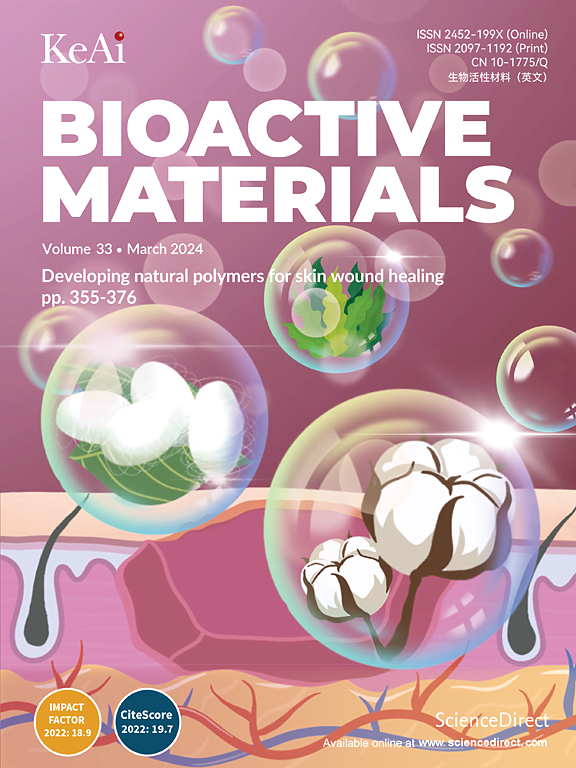在轻度缺氧条件下,持续释氧水凝胶植入物通过促进线粒体生物发生促进皮瓣再生
IF 18
1区 医学
Q1 ENGINEERING, BIOMEDICAL
引用次数: 0
摘要
在再生医学中,外科皮瓣组织缺血的有效管理至关重要,但具有挑战性,特别是因为血流不足往往导致远端皮瓣尖端坏死。本研究旨在研究过氧化氢酶包被的产氧微粒嵌入明胶甲基丙烯酰(cOMP-GelMA)水凝胶的治疗潜力,以建立有利于组织再生的优化环境。采用3 × 9 cm2大鼠随机皮瓣模型,评估四组皮瓣的存活和再生:对照组、纯GelMA水凝胶和cOMP-GelMA水凝胶,其中cOMP-GelMA水凝胶含有两种浓度的coms(0.2%和0.5% w/v)。这些发现表明,与0.5% cOMP-GelMA相比,含有0.2% OMP的cOMP-GelMA显著增强了血管生成、动脉生成、线粒体生物生成和抗氧化能力。此外,较低浓度的cOMP比较高浓度的cOMP对炎症反应的缓解更为明显。这些结果表明,通过过氧化物酶体增殖体激活受体γ辅助激活因子1-和缺氧诱导因子1-依赖的信号通路,在适度氧输送的促进下,轻度缺氧有利于组织修复和再生。本研究强调了利用大规模模型探索轻度缺氧治疗益处的创新之处,并表明通过coms控制氧输送可以改善缺血组织的长期功能恢复。本文章由计算机程序翻译,如有差异,请以英文原文为准。
Sustained oxygen-releasing hydrogel implants enhance flap regeneration by promoting mitochondrial biogenesis under mild hypoxia
In regenerative medicine, effective management of tissue ischemia in surgical skin flaps is crucial, yet challenging, particularly because inadequate blood flow often leads to necrosis at the distal flap tips. This study aimed to examine the therapeutic potential of catalase-coated oxygen-generating microparticles embedded in gelatin methacryloyl (cOMP-GelMA) hydrogel to establish an optimized environment conducive to tissue regeneration. Using a large 3 × 9 cm2 rat random-pattern skin flap model, flap survival and regeneration were evaluated across four groups: control, pure GelMA hydrogel, and cOMP-GelMA hydrogel with two concentrations of cOMPs (0.2 % and 0.5 % w/v). These findings revealed that cOMP-GelMA comprising 0.2 % OMP significantly enhanced angiogenesis, arteriogenesis, mitochondrial biogenesis, and antioxidant capacity compared to 0.5 % cOMP-GelMA. Furthermore, the alleviation of the inflammatory response was more pronounced at lower cOMP concentrations than at higher concentrations. These results demonstrate that mild hypoxia, facilitated by moderate oxygen delivery, is beneficial for tissue repair and regeneration through peroxisome proliferator-activated receptor gamma coactivator 1-alpha- and hypoxia-inducible factor 1-alpha-dependent signaling pathways. This study highlights the innovative aspect of using a large-scale model to explore the therapeutic benefits of mild hypoxia and suggests that controlled oxygen delivery by cOMPs can improve the long-term functional recovery of ischemic tissues.
求助全文
通过发布文献求助,成功后即可免费获取论文全文。
去求助
来源期刊

Bioactive Materials
Biochemistry, Genetics and Molecular Biology-Biotechnology
CiteScore
28.00
自引率
6.30%
发文量
436
审稿时长
20 days
期刊介绍:
Bioactive Materials is a peer-reviewed research publication that focuses on advancements in bioactive materials. The journal accepts research papers, reviews, and rapid communications in the field of next-generation biomaterials that interact with cells, tissues, and organs in various living organisms.
The primary goal of Bioactive Materials is to promote the science and engineering of biomaterials that exhibit adaptiveness to the biological environment. These materials are specifically designed to stimulate or direct appropriate cell and tissue responses or regulate interactions with microorganisms.
The journal covers a wide range of bioactive materials, including those that are engineered or designed in terms of their physical form (e.g. particulate, fiber), topology (e.g. porosity, surface roughness), or dimensions (ranging from macro to nano-scales). Contributions are sought from the following categories of bioactive materials:
Bioactive metals and alloys
Bioactive inorganics: ceramics, glasses, and carbon-based materials
Bioactive polymers and gels
Bioactive materials derived from natural sources
Bioactive composites
These materials find applications in human and veterinary medicine, such as implants, tissue engineering scaffolds, cell/drug/gene carriers, as well as imaging and sensing devices.
 求助内容:
求助内容: 应助结果提醒方式:
应助结果提醒方式:


